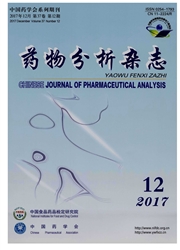

 中文摘要:
中文摘要:
目的:表征2种呫吨酮类化合物(1-hydroxy-7-methoxyxanthone,HM;dehydrocycloguanandin,DC)与人血清白蛋白(human serum albumin,HSA)的键合作用。方法:在模拟生理条件下,应用计算机模拟技术,并结合荧光光谱法和紫外吸收光谱法研究药物与蛋白的相互作用。结果:分子模拟显示了DC及HM与HSA的键合区域和键合模式,表明维持药物与蛋白质的相互作用力主要是疏水作用,兼有位于不同氨基酸残基的氢键。荧光光谱实验结果表明:这2种呫吨酮类化合物对HSA的荧光在一定的浓度范围内都有猝灭作用,猝灭方式均为静态猝灭。紫外光谱图表明它们对蛋白微环境有影响。根据荧光滴定数据,求出了不同温度下(296,303,310 K)反应的结合常数及反应热力学参数。通过竞争实验确定了这2种药物在蛋白上的不同结合位点。结论:在分子水平上揭示了这2种呫吨酮类化合物与HSA有不同的、较强的键合作用。
 英文摘要:
英文摘要:
Objective:To characterize the binding between two xanthones(1-hydroxy-7-methoxyxanthone,HM;dehydrocycloguanandin,DC)and human serum albumin(HSA).Methods:A combination of intrinsic fluorescence,absorption spectroscopy and the molecular modeling techniques had been used to investigate the interaction between two drugs and HSA.Results:Molecular docking was performed to reveal the possible binding mode or mechanism and suggested that DC and HM can strongly bind to HSA.It is considered that DC or HM bind to HSA mainly by a hydrophobic interaction and there are different hydrogen bonds interactions between the drug and the residues.The results from fluorescence spectroscopy indicated that the two drugs could quench the fluorescence of HSA and showed static quenching mechanism.The evidences from fluorescence and absorption spectroscopes discussed the effect of DC or HM on the microenvironment around HSA in aqueous solution.The binding constants and the thermodynamic parameters between DC or HM and HSA at different temperatures(296,303 and 310 K)were calculated according to the data obtained from fluorescence titration.The competitive experiments suggested that the primary binding site of two drugs was located in site Ⅱ of HSA for DC and site Ⅰ of HSA for HM,respectively.Conclusion:It is revealed that two xanthones can strongly and distinctly bind to HSA at molecular level.
 同期刊论文项目
同期刊论文项目
 同项目期刊论文
同项目期刊论文
 期刊信息
期刊信息
